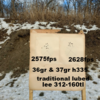usmc0811
Member
I have 7 piles of pure lead about 15 pounds each of mixed pipe, wheel weight and fishing sinkers. And two other smaller piles of 50/50 tin lead and 40/60 tin /lead . I want to make handgun bullets but dont know how I should mix it all together. How much of the 50/50 should I mix in with the 15 pound piles of straight lead. I have pictures but cant seem to get them on the computer, Ill keep trying.




